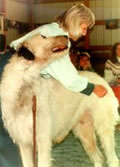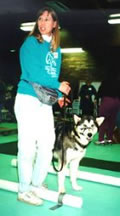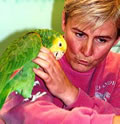A Description of TTouch® Trainings with Dogs and other Companion Animals!!
TTouch Workshops, Trainings:
Hands-On Workshops - one-day or two-days.
Series of Hands-On Trainings to Groups - one session per week, afternoon or evening, for 6-8 weeks.
Six-Day Trainings - These six-day trainings serve as a Foundation Training to learn the basics of the Tellington Method and also are part of the continuing six-session TTouch Certification Program.
 In Tellington TTouch week-long trainings and one- or two-day workshops, Linda Tellington-Jones, Robyn Hood, the Instructors and TTouch Practitioners provide a learning environment that is hands-on, very supportive and safe for the human participants as well as for the dogs and other animals who attend the trainings. The majority of work in the trainings is done with dogs, but some Practitioners specialize in working with cats, bunnies, reptiles, birds and other small pets. TTouch trainings provide a relaxed atmosphere where sharing information and ideas is encouraged.
In Tellington TTouch week-long trainings and one- or two-day workshops, Linda Tellington-Jones, Robyn Hood, the Instructors and TTouch Practitioners provide a learning environment that is hands-on, very supportive and safe for the human participants as well as for the dogs and other animals who attend the trainings. The majority of work in the trainings is done with dogs, but some Practitioners specialize in working with cats, bunnies, reptiles, birds and other small pets. TTouch trainings provide a relaxed atmosphere where sharing information and ideas is encouraged.
In each of these trainings, attendees will include students from all levels of the program - from the first through the sixth. For more than twenty years, we have found that this combination has provided a rich exchange of ideas and experiences to all participants.
Following are comments of participants at a two-day, hands-on workshop that included some challenging dogs and some remarkable turnarounds. Georgiann Schneider has been trainer for a decade and a half and specializes in Rottweilers. On her evaluation form she wrote:
 "I have had my female Rottweiler for one month. I have had many Rotties over the years but this new one was very hyperactive. I have always used a lot of touching to develop a bond with new dogs. This new female was so stimulated by me being near her that I could not get her to hold still to be petted. She’d jump all over me in her excitement and never settled down, so after 10 minutes I would have to confine her to her crate or kennel.
"I have had my female Rottweiler for one month. I have had many Rotties over the years but this new one was very hyperactive. I have always used a lot of touching to develop a bond with new dogs. This new female was so stimulated by me being near her that I could not get her to hold still to be petted. She’d jump all over me in her excitement and never settled down, so after 10 minutes I would have to confine her to her crate or kennel.
"On the second morning of the seminar, my 'hyperactive' dog entered the seminar room, looked around for 10 minutes and then lay quietly at my feet (awake - not asleep!) for the next 50 minutes. I would have been satisfied if she would have held still for 10 minutes, but for her to be able to lay quietly in a room full of dogs (not always quiet) is truly unbelievable. If I hadn't been there in person, I wouldn't have believed it!"
 Replying to the question "What are the most important things you learned from the workshop?", on participant said: "TTouch teaches love, understanding and respect".
Replying to the question "What are the most important things you learned from the workshop?", on participant said: "TTouch teaches love, understanding and respect".
Douglas A. Miller, a trainer from the Los Angeles area, brought a dog-aggressive Border collie. Douglas was just curious about the TTEAM method and said he had not really expected a big change. By the end of the two days, his dog was completely comfortable and non-aggressive with the 15 dogs in the seminar. He wrote: "TTouch offers a non-violent, humane approach to working with and training animals. It has changed my life and the life of all animals I will ever work with!"
 Christine DiGuesto stated: "The most important thing I learned is that there are individual personalities, behaviors, and needs in our companion animals just as among ourselves, and that respect and understanding of these differences is important. I feel that the work we can do with TTouch for our companion animals can teach us how to better relate to our fellow human beings. In a few hours of working with Linda, I have truly become more aware of the power of this kind of communication. TTouch can make the world a better place for all."
Christine DiGuesto stated: "The most important thing I learned is that there are individual personalities, behaviors, and needs in our companion animals just as among ourselves, and that respect and understanding of these differences is important. I feel that the work we can do with TTouch for our companion animals can teach us how to better relate to our fellow human beings. In a few hours of working with Linda, I have truly become more aware of the power of this kind of communication. TTouch can make the world a better place for all."
 Christine rides endurance and has used the TTouch for several years to calm and focus her horse. In the training, she worked with a dog from the Pasadena Humane Society who was considered unadoptable. Christine wrote on her evaluation form: "This weekend I brought a very mouthy shelter dog to the workshop. The change has been incredible. He went from being a hyperactive blur that chewed on everyone and everything to a balanced, thinking creature."
Christine rides endurance and has used the TTouch for several years to calm and focus her horse. In the training, she worked with a dog from the Pasadena Humane Society who was considered unadoptable. Christine wrote on her evaluation form: "This weekend I brought a very mouthy shelter dog to the workshop. The change has been incredible. He went from being a hyperactive blur that chewed on everyone and everything to a balanced, thinking creature."
Another participant wrote, "My two female shepherd-mixes used to fight for dominance at home and wound up at the vet office twice needing stitches. The younger female (challenger) is now noticeably calmer and has regained respect for her older companion. The older female currently is being worked on to regain her old self-confidence."
Evan Ozahawk, a volunteer at the Pasadena Humane Society for several years, wrote, "I thought claims and previous comments were clearly exaggerated. I can say after two days that all was true. I was truly amazed at the results on which I thought were hopeless cases."
TTouch Your Dog
by Kate Riordan
TTouch Philosophy
The TTouch method of training dogs honors and respects the animal, focuses on cooperation rather than dominance, values the dog as a participating family member, uses specific TTouches as training tools, and incorporates kindness and forgiveness into its philosophy. This training method reflects the belief that animals are intelligent and can easily understand what we want without threats, pain or anxiety. The TTouch method allows the dog to attain a mental, physical and emotional balance that contributes to a happy companion animal.
Obedience is necessary for the dog's own safety and well being. Well-behaved dogs are more socially acceptable and are generally just more agreeable to be around. The TTouch method of training enables you to make clear agreements with the dog, allowing the animal to fulfill a social contract with the family and to fit in as a family member. Traditional training involves a variety of means-to-an-end methods, but often in the process the animal must go through levels of anxiety, fear, punishment and miscommunication. The TTouch method, with its unique TTouch physical connection with the dog and its practical, humane philosophy, is an alternative that provides successful rewards for both dogs and handlers. Having a happy, cooperative, obedient dog brings joy beyond words.
One of the basic precepts of this approach to training is to create an environment wherein the dog wants to willingly participate with you and please you. An encouraging tone of voice, an attitude of kindness and loving, and giving clear, non-threatening commands are part of this bridge building. The TTouches are a critical link in inspiring the animal’s response: the TTouches ground the dog, create a base of self-control, promote thinking beyond mere instinct, and enable the dog to do what we ask in a positive manner. Combining verbal, visual, spatial and kinesthetic modes of training enhances the dog's ability to learn.
TTouches introduce new alternatives into the world of dog training. The circular TTouches activate brain wave patterns that in human studies have been shown to be present during the learning process. Doing the TTouches on dogs relates to them in an entirely new manner, inciting the part of the brain that allows the dog to learn, making the training an easier, more humane procedure. The TTouch methodology is a radical departure from other trainings, including choke-chain jerking methods that are painful and frightening and have been shown to damage soft tissue and vertebrae in the throat and pelvic areas.
It is critical to hold a clear expectation of the desired result of your training requests. Focus on what the goal is, rather than on what the dog is doing wrong. Visualizing the optimum goal is the first step; hold a mental picture of exactly what you want the dog to do. With the TTouch method, you have a number of alternatives should the dog not properly respond. Once the dog succeeds, however, reinforce the response with loving, enthusiastic words, physical contact and the occasional food treat.

